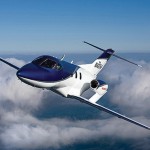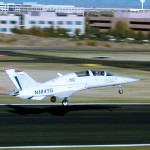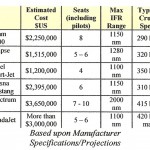By Ron McElroy
A funny thing happened to general aviation that was largely unnoticed as we crossed into the 21st century. As most aircraft companies and pilots were looking to squeeze more speed and payload out of the traditional airframes of yesteryear, a few inspired engineers, pilots and entrepreneurs were silently developing a new and exciting opportunity for the aviation community to truly experience the hope of affordable and fast transportation in the skies.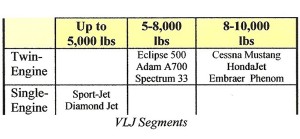
Not that there was instant success. In fact, even now there are few victories to celebrate in the emerging market of very light jets.
In a nutshell, VLJs weren’t even practical until a revolutionary engine could be developed to support the vision: light weight, lots of thrust, low cost and efficient fuel consumption. Thankfully, that engine was designed and perfected. And that’s where we are today—at the threshold of a new marketplace for general aviation.
Most have only recently heard of this forecast upheaval of VLJs. So, to facilitate the understanding for all of us, let’s start from the beginning and see where the seed of VLJs was planted, and how it has since blossomed. Then, it’s also important to have a fundamental understanding of the marketplace, insurance for this new breed of planes and pilots, and training of pilots.
What is a VLJ?
A very light jet is a production jet aircraft certified under FAR Part 23, generally accepted to have a maximum takeoff gross weight of 10,000 pounds or less. A VLJ has one or two modern turbofan engines, approval for one or two pilot operations, and a total seating capacity of eight or less, including the pilots.
The intended use of the airplane is equally important. As an example, Excel Jet’s Sport-Jet may be better suited as simply an upgrade from the current single-engine piston airplane fleet or, perhaps, a light twin, and is intended to be used largely as an entry-level jet for personal use. Some have labeled this category as the personal jet (PJ). At the other end of the scale, the Cessna Mustang might offer an economic alternative to the corporate flight department or air taxi operator looking for a low-cost alternative to their current fleet of airplanes.
Also, recognize special categories and off-shoot airplanes within the VLJ definition. Consider Aviation Technology Group’s Javelin as an example of a special use VLJ in its own category, due to its unique configuration, performance and mission profile. Also, VLJs offered in the marketplace are labeled as “custom-built” or experimental. This category will not be addressed due to its restricted use or limited appeal to most general aviation pilots.
History
The current development of the VLJ aircraft could do for GA what Bill Lear did for corporate aviation with the Learjet in 1963. In the decades since, many have tried, with minimal success, to create a jet airplane market for the general aviation pilot: the Bede 5J (circa 1973), Foxjet (circa 1977), Gulfstream Peregrine (circa 1983) and others.
All of these early projects suffered from the hype of performance goals that simply weren’t achievable in a consistent, practical, efficient and safe aircraft design. The single greatest factor to limit their future success was due to the engine limitations at the time: too little thrust to weight, low reliability, high cost, high fuel burn rates and marginal performance.
It hasn’t been until recent years that the technology advances of the jet engine, namely the small turbofans, have more closely matched the needs of these smaller jets. Thanks to the ongoing pioneering efforts of Sam Williams, the Williams FJ33 engine and derivatives have dramatically changed forever the landscape of personal jet aviation. Pratt & Whitney has also risen to the challenge to enter the market with their small turbofan engines.
The technology in these new small turbofan engines has demonstrated a significantly increased level of safety and reliability, ease of operation (with the FADEC), lower maintenance costs, lower fuel consumption, and significantly higher thrust to weight ratios.
NASA
In November 2000, NASA initiated concept meetings to develop industry partnerships with the common goal of exploring better products and systems to capture technologies that would enhance the flying experience for the general public. This led to the development of the Small Aircraft Transportation System program. Their vision as stated on their website is as follows: The small aircraft transportation vision is a safe travel alternative, freeing people and products from transportation system delays, by creating access to more communities in less time.
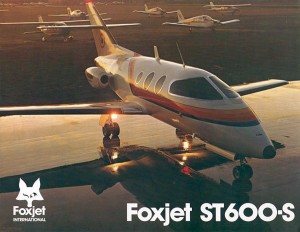
Many have tried, with minimal success, to create a jet airplane market for the general aviation pilot, including the Foxjet.
With this government move towards advancing the small aircraft flying environment, and the parallel effort by private industry to create the VLJ market, a synergy has only now developed to promote the VLJ concept. The reason for this is the combined regulatory framework, industry recognition, public need and financial robustness to support both the investor and consumer.
Until now, the VLJ industry has been severely fragmented and plagued by failures of promises to deliver, lack of financial support, and questionable engine and airframe combinations promoted by marketers, rather than proven designs by accomplished aerodynamic engineers with the knowledge to achieve a total package of success from start to finish.
Marketplace
For the past two decades, GA has suffered from a lack of product selection for many pilots to upgrade to or replace outdated airplanes. Until recently, there hadn’t been a seriously upgraded production airplane design for many decades.
Rather, manufacturers opted for expensive aerodynamic “clean-up” projects to allow marginally faster speeds with new fixed-gear designs, or upgraded turbocharged engines and “glass cockpit” upgrades to entice those looking for a more modern aircraft.
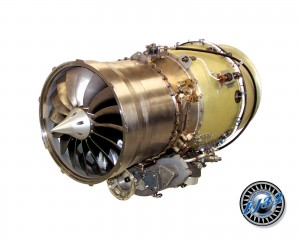
The Williams FJ33 engine and derivatives have dramatically changed forever the landscape of personal jet aviation.
Since Cessna discontinued its light-twin production in the mid-1980s, essentially no corporate twins have been available. The VLJ builders now hope their aircraft will serve as replacements for many older piston twins and turboprops.
Even the Honeywell 14th Annual Business Aviation Outlook has started taking a serious look at the potential impact of the VLJ market. Honeywell refers to these aircraft as the ultra light/personal jets because of the stratification of size, cost and performance within the VLJ segment. Honeywell’s survey published in November 2005 predicts that 4,500 to 5,500 VLJs will be delivered to customers in the next 10 years! These deliveries will be to the traditional corporate flight departments (800 to 900) and owner-flown (3,700 to 4,600) segments that Honeywell expects will grow up around the VLJs.
In addition, Honeywell’s forecast doesn’t include potential VLJ customers from fractional ownership companies or air-taxi operations that may be created. The air-taxi market may also develop into a large segment of the deliveries; Eclipse reports that about two-thirds of its 2,357 order backlog is tied to that market.
Separately, Rolls-Royce forecasts delivery of about 7,500 VLJs during its 20-year forecast. Embraer forecasts 2,515 VLJ deliveries between 2006 and 2016, plus deliveries to the air-taxi market of 2,500 to 3,000 additional aircraft over the 10-year period.
It seems that the industry forecasters are in agreement that the VLJ market is developing at a substantial rate, as proven by the current backlog of orders from the manufacturers: Eclipse, 2,357; Adam, 282; Cessna, 230.
As a pilot/owner businessman, if you were looking at a brand new light twin costing over one million dollars that cruises at 200 knots, and a brand new VLJ costing a little more but with over 300 knots cruise speed, which would you choose? The noisy, temperamental piston-engine airplane or the quiet, simple-to-operate, and faster jet airplane, for about the same price?
Then again, do you think you and one or two of your pilot pals would consider partnering on a VLJ that provides pressurized comfort with twice the speed at twice the altitude as a new Bonanza, for the same or lower purchase price per pilot? Then you could literally hop a jet for the day to play golf at your favorite location or close that critical business deal face to face and still make it home in time for dinner, all without breaking the budget for the sake of a jet time machine. Not to mention the hassles and extra time that would’ve been otherwise needed to use traditional airlines.
Doesn’t it make sense that VLJs can offer real value compared to the “legacy” aircraft leftovers?
Insurance
Insurance underwriters are going to have a tremendous voice in allowing you to fly a VLJ, if you desire to have insurance protection at all—unless you want to be self-insured, that is. Therein lies a major challenge to the VLJ manufacturers and marketing teams: how to ensure that the consumer can insure the product being sold.
There are currently no parameters or criteria for establishing a set of guidelines for premiums to insure the VLJ and pilot(s). In other words, according to insurance sources, it’s too far out in the future to know how the insurance market will react, via premiums, to VLJs. A few companies have advertised to customers guaranteed insurability upon successful completion of their approved training program, and these same companies also advertise “typical” premiums. Be assured that there are no “typical” premiums, but, rather, optimism that the rates won’t be too high.
Underwriters face some issues. First, the entire aviation industry considers the VLJ to be a technically advanced aircraft. A TAA is an aircraft that contains GPS navigation with a moving map, plus any additional systems such as integrated autopilots, advanced engine management and glass cockpit avionics. Typically, new TAAs also have a greater performance envelope (speed, range, altitude) than “legacy” aircraft.
Second, much of the lure of the VLJ is for the GA pilot. This pilot may be new to this operating environment at jet speeds, high altitude operations and weather, pressurization, more complex aircraft systems, etc. Therefore, this same pilot will likely require extensive training, to develop the experience necessary to ensure the safety of himself and passengers, but, also, to ensure the insurability of himself, passengers and aircraft.
This would be analogous to taking a new military recruit fresh out of basic training and throwing him into a combat situation with an advanced fighter, or putting a 500-hour CFII into the left seat of a Gulfstream IV or Boeing 777. And, we do, in fact, plan on doing those very things. However, it’s normally done over an extended period of time, with strict adherence to a training syllabus and career progression.
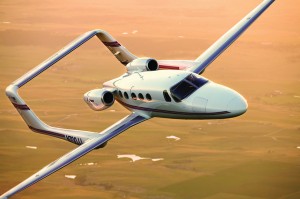
Doesn’t it make sense that the VLJs like the A700 can offer real value compared to the “legacy” aircraft leftovers?
The question to be answered then is who will be flying the VLJ and how should he train to gain the experience and competence to ensure safety, proficiency and insurability? That leads to the third issue: training. This is new territory for GA pilots and the training community. Basically, never before has there been such a large and broad population of pilots who may now be able to afford the opportunity to fly jets heretofore reserved for only the airlines, military and professional corporate pilots.
We already have evidence within the aviation community that there is a training challenge for a successful outcome with just these first two issues: TAA combined with a GA pilot.
Training
Recently, just in time for the VLJs and other glass-cockpit aircraft, the FAA has partnered with industry and academia to create the FAA/Industry Training Standards program to develop scenario-based, learner-focused training that encourages practical application of knowledge and skills. The goal is to help pilots of TAA develop risk-management skills and in-depth systems knowledge needed to safely operate and maximize the capability of these aircraft in the National Airspace System.
The participants of FITS are currently developing a framework for curricula for the customers, particularly in the new TAAs and upgraded glass-cockpit airplanes.
Once the curriculum is established, the trainers will conduct an evaluation of the pilot to establish an entry point to the staged FITS training profile. In other words, an inexperienced pilot may require the entire training program while a more experienced pilot may “test out” due to his qualifications and thereby start the training program at a more advanced level than the inexperienced pilot.
But, there are two subsets of training that might generate quite a stir of controversy: use of simulator devices and the need for training mentors to “baby-sit” the newly qualified VLJ pilot while he’s gaining experience/hours in the type of aircraft. Even now, the major VLJ manufacturers have initially taken different approaches to addressing the training needs of their customers.

Level 5 fixed based simulators, such as this Paradigm Shift Solutions CRJ-200 simulator, may just as easily allow reasonable fidelity of training for a large part of the VLJ curriculum.
Key industry players will likely push for the acceptance of high-fidelity Level D full-motion simulators for training. At a development cost of minimally $30 million dollars a unit, this could be a heavily debated upfront cost. As an alternate, use of extended classroom and mockup Level 5 fixed-based simulators may just as easily allow reasonable fidelity of training for a large part of the curriculum, supplemented by in-aircraft flight training as needed. Or, some manufacturers may choose to develop only a classroom and airplane training program, much as we have done in traditional flight training for many years, to avoid the cost of simulator development.
The latter will be heavily scrutinized as the availability, affordability and maturity of simulators improve, and FITS participation becomes the normal requirement for the insurance industry and FAA oversight.
The use of mentors to supplement the formal initial training and qualification is likely to be a stipulated requirement for the insurance community. Why? First, FAA and insurance approval for single-pilot jet operations continue to be a difficult challenge for almost any light jet and some turboprops.
Statistically, the underwriters acknowledge greater risk with a single pilot in the demanding operational flight environment normally regulated in the past to two-pilot professional operations. Similarly, two heads in the cockpit are better than one. Also, the mentor pilot concurrently oversees and instructs the new VLJ pilot as he encounters new situations in the process of gaining additional flight time in this type of aircraft.
The fourth issue faced by underwriters is that they subject all pilots to an evaluation of their experience, training and ratings. The policy premium depends greatly on the type of training program, total number of flight hours, flight time in type of aircraft to be insured, ratings such as single-engine versus multi-engine and instructor ratings and commercial or airline transport certificates.
The question isn’t necessarily how much the premium to insure will cost, but, rather, can the insurance coverage be provided at all? Simply put, a GA pilot with only single-engine piston aircraft experience and training will be denied coverage for most of the VLJs because, except for a few, they’re twin-engine aircraft. Even when this same pilot gains a multi-engine certificate, coverage may not be allowed until he gains an additional amount of flight time in multi-engine turbine aircraft, which is a tremendous commitment of resources to achieve.
On the other hand, there may be an advantage for a pilot to gain experience in a lower-cost, single-engine VLJ, to build time and gain experience in high-performance operations prior to moving ahead to a twin-engine jet. This approach may have some appeal to the insurance underwriters as they evaluate your training and experience.
It’s not uncommon for an energetic and financially able GA pilot to be ecstatic and relieved to have the privilege of paying exorbitant premiums for the excitement of flying a new type of fancy aircraft to use in business, on family trips, or to impress his friends. In that vein, it’s not necessarily the premium that makes a difference to the new pilot; it’s the fact that he can be qualified to get coverage at all by any underwriter.
The big picture in training any pilot, novice or professional, is the success in achieving an incremental increase in his flying skills and judgment. The key, though, is to recognize and blend the role of the aircraft’s systems, performance and displays, as a TAA, in developing and enhancing the pilot’s situational awareness.
When situational awareness is improved, safety is improved, risks are minimized, and the cost of insurance becomes more affordable to further support the premise of the very light jet experience: cost effective transportation at jet speeds for general aviation.
Design
The fifth and last issue is the underwriter’s evaluation of the risk associated with the overall safety design of the aircraft. In other words, what is inherent to the design of the aircraft to mitigate the risk and damage to the aircraft and crew and passengers in the event of an accident?
The design of VLJs, after a period of perhaps five to 10 years, will provide a statistical validation of the risk of accidents and incidents. Over the years, some aircraft will be considered safer, with lower risk compared to others. That statistic is directly related to design features of the airplane. These influencing design safety features could be items such as:
1) Repair costs of a wing dent due to a taxi or hangar incident
2) Repair costs and fatalities or injuries due to an off-runway landing or overshoot (e.g. B737 at BUR and MDW)
3) Lower approach speeds, which lessen the energy of impact upon landing or ditching
4) Stall/spin characteristics
5) Airframe and engine icing tolerance
6) Location of fuel tanks as a trigger for fire exposure to passengers upon a crash landing
7) Simplicity of aircraft subsystems under normal and emergency operations
8) Emergency egress capability Performance
Generally speaking, VLJs are touted as having “jet-like” speeds that bridge the gap between traditional piston-engine aircraft and corporate/airliner speeds. That would segregate the range as somewhere between 240 knots true airspeed at the low end and 380 ktas at the high end, except for the Javelin, which is expected to cruise greater than 500 ktas.
With the range of maximum and economy speed combinations with maximum altitudes proclaimed to be anywhere from FL250 up to FL410, there’s a likely niche choice of products to suit your mission profile and budget. Obviously, to go higher and faster with more passengers is more expensive.
By the way, in the early stage of this new VLJ industry, be very careful to validate specification promises to actual performance from flight test. Several programs to date have fallen short of the original design goals. So make sure your purchase deposit is tied to achievement of these goals.
A simplified approach to identifying those aircraft suitable for your mission needs is to focus on these specifications, for starters:
1) Thrust-to-weight ratio
2) Climb and descent speeds
3) Long range (economy) cruise speed vs. maximum cruise speed
4) Range vs. total fuel burn
5) Range vs. useful load
Thrust-to-weight ratio: This helps determine the ability to take off from a short length runway and then climb to a cruise altitude. Overall, there’s a benefit to reach a high cruise altitude quicker, resulting in a higher true airspeed and lower fuel burn rate; it’s more fuel efficient to get to a high cruise altitude as quickly as practical. Higher thrust-to-weight ratios result in better overall performance.
Climb and descent speeds: VLJs will exhibit a moderately wide range of climb and descent speeds from one model to another. Industry observers speculate that one VLJ may climb at 120–140 knots indicated airspeed while another climbs at 180–200 kias to get to a cruising altitude.
The reason this makes a difference is that the time, distance and fuel to climb to cruise altitude (and subsequently descend) can dramatically impact the overall block to block time and costs for your flight. Favor aircraft that have the best combination of forward speed during the climb and descent, while minimizing the time to climb to cruise altitude.
LRC vs. maximum cruise speed: Although having a high maximum cruise speed sounds great and is very alluring to a speed fanatic, pay closer attention to the long range or economy cruise speeds that will make more sense for your mission and budget.
In the analysis, however, if there’s a significant lowering of flight time on the engine and airframe despite an increase in the amount of fuel burned, using a higher cruise speed may save the operator money. In other words, if the savings in hourly rates for engine maintenance and reserve costs, by going at a faster speed, outweigh the additional fuel costs at a faster speed, then using a faster cruise speed may make economic sense.
Range vs. total fuel burn: For a chosen cruising speed, this number is the miles per gallon, or how efficiently the airplane operates. With remarkable fuel prices these days, know clearly how one model of VLJ compares to another. This is the immediate direct operating cost for the airplane.
Range vs. fuel load: Many larger airplanes have critical combinations of fuel loading vs. passengers/cargo that impact the overall range of the airplane. In one example, with six passengers you may be weight restricted to carrying only 100 gallons of Jet A. This restricts you to a one-hour flight (with reserves) or a 250 nm range. In another example using the same VLJ, you may need to carry a full fuel load to fly 1,000 nm to a business meeting; but, this also gives you a weight restriction allowing only two passengers on the flight.
Make sure you get complete weight and balance and mission profiles before making a final decision on purchase.
Industry studies show that owners of high-priced aircraft, including private twins and corporate-sized jets, do not use the passenger capacity and range for which they paid. Ninety percent of the 500 flights per day undertaken by U.S. fractional jet owners are for fewer than three people and 400 miles.
Seating capacity
VLJs currently offer anywhere from four to nine seats. However, NASA AGATE studies show that 96 percent of corporate and business aircraft flights are conducted with two or fewer passengers. Just as people commute to work with only themselves or one passenger in a car, business aviation is the same.
Also evaluate the seating arrangement: cabin width and height, leg room and amenities. Of particular note here is that given the relative shorter distance flights on the VLJs, an in-flight bathroom may not be available.
Seating capacity also impacts insurance requirements for liability and premiums; more seats available to carry passengers mean greater liability in the event of an accident.
Air traffic control
There’s a slowly brewing groundswell of positioning from the big airplane world to protect “their” airspace from the congestion and interference of the swarm of VLJs envisioned for the future.
There’s also legitimacy to the argument that air traffic control will be challenged to mix the slower VLJs with the faster corporate airplanes and airlines in the higher altitudes in congested areas of the country, such as the eastern seaboard and parts of the west coast of California. Hopefully, the argument will be solved with procedures limited to a somewhat small segment of the U.S. Only time will tell.
Consider for a moment, though, the practicality of a VLJ flying at FL410 along with RVSM requirements, range and fuel efficiencies, and the physiological training requirements for high altitude operations.
Reduced Vertical Separation Minimum: Effective Jan. 10, 2005, RVSM was implemented in the U.S. from FL290 to FL410 to reduce the vertical separation above FL290 from the 2,000-ft minimum to 1000-ft minimum. This allows aircraft to safely fly more optimum profiles, gain fuel savings and increase airspace capacity. However, the cost to be equipped or retrofitted for RVSM is approximately $100,000. Many operators will choose to operate below FL290 at least temporarily while the accountants justify the expense and unleash the funding for this mandatory equipment upgrade. The question: Is RVSM capability for VLJs cost effective?
Range and fuel efficiencies: Jet airplanes have greater range as they climb and cruise at higher altitudes approaching their cruise altitude service ceiling. This is especially significant for large aircraft and medium- to long-distance flights.
However, advantage is minimized for shorter distance missions of the VLJs and their corresponding slower V-speeds and climb/descent speeds. In fact, analysis shows that typical VLJ missions would rarely require flight above FL290 where RVSM airspace begins. Although this issue is really performance related, it’s also appropriate to be discussed as a subset of ATC because of the possible altitude limitations placed on VLJs while en route.
As an example, VLJ #1 may climb at 140 kias to FL350, where it has a nice cruise speed of 330 ktas. After a normal descent and landing, VLJ #1 uses 160 gallons of Jet A during its 2 hr., 40 min. flight, covering 800 nm.
VLJ #2 climbs at a more impressive 200 kias to FL240 cruise altitude, where it has a more moderate cruise speed of 310 ktas. After a normal descent and landing, VLJ #2 uses only 145 gallons of Jet A during its flight of 2 hr., 30 min., covering the same 800 nm. Savings = 15 gallons and 10 minutes!
Let’s examine the different components and advantages shown by VLJ #2:
1) VLJ #2 has better forward speed but doesn’t have to climb as high as VLJ #1, thus reducing the amount of time required at the high fuel burn rate during the climb. As such, VLJ #2 can get to its more efficient cruise speed in a shorter time and distance with less fuel required.
2) VLJ #2 gets to its cruise altitude of FL250 quicker than VLJ #1, and outpaces the slower climb speed of VLJ #1. In fact, VLJ #2 should easily outrun VLJ #1 from the beginning, even though it has a slightly lower cruise speed at altitude.
3) An added benefit to the lower block time of VLJ #2 is the reduced cost of operating the engine. Each operating minute costs about $2 in engine costs.
Physiological training: The FAA requires additional training and equipment to fly an airplane above FL250, simply due to the increased risk of hypoxia caused by pressurization malfunctions or other issues necessitating a rapid descent from a higher altitude. This is an added upfront cost to the customer.
FAR 61.31 and 91.211 outline the training and equipment requirements for these high altitude operations. The regulatory requirements aren’t trivial and highlight the increased risk of high altitude operations.
Altogether, the RVSM, performance and physiological issues for flight above FL250 need to be purposefully analyzed and justified to help determine the type of aircraft to buy for the profile of missions to be flown.
Cost
Marketing materials for the VLJs reveal a sales price range of around $1,000,000 up to $4,000,000. The higher cost airplanes usually perform at somewhat faster speeds than those at the lower price range, and usually have more seating capacity (and a toilet).
Conclusion
The VLJ market is somewhat difficult to assess because of three overriding factors: the elusiveness of accurate performance data; the unknown cost of training and insurability; and the fact that this is a new and emerging marketplace that drives tempting new initiatives within the FAA to regulate manufacturing, training and airspace. However, it’s exciting because the choice and opportunity for new airplanes hasn’t been this dramatic and available for many decades.
Many manufacturers have trumpeted the ease at which a GA pilot is going to be able to afford to buy and operate, train and qualify, and then obtain insurance for their particular model of VLJ—using their approved training program, of course. As a GA pilot with only piston-engine experience, you must accept that there is a great likelihood that this will not be the case! Most of the VLJs will require a lot of time and cost to train to be proficient and safe as pilot in command without an instructor or mentor assisting in the cockpit.
Therefore, considering the concerns of the insurance underwriter, it seems that the first logical step for a GA pilot is to consider starting with a single-engine VLJ such as the Sport-Jet, then progressing to a twin-engine VLJ after gaining the needed experience. This allows the pilot to build flight time in a jet that’s simpler to operate, while operating at jet speeds in a high altitude environment. Aviation insurance underwriters prefer to see that kind of training and experience progression in their client’s aircraft.
On the other hand, for professional pilots in an air-taxi operation or corporate flight department, the twin-engine VLJs may provide needed financial relief as a lower-cost alternative to the current fleet of jets.
Marketing surveys discussed earlier in this article suggest that once the GA pilot finds out there’s a VLJ he can be trained to fly, sales will blossom for the manufacturer that builds jet-transition simplicity into the training and operation for that new GA jet pilot.
As the VLJ market grows, most likely, the airplanes that have the lowest purchase price, operating costs, and insurance premiums for the GA pilot will sell faster than the more expensive VLJs. And, since most flights carry only a couple of passengers on relatively short distance flights, VLJs with more than four to five total seats may not be worth the extra money to the GA pilot. Also, a VLJ that can climb to FL410 likely will not be a big advantage. More importantly, single-engine VLJs (or PJs) will have greater appeal for insurance and training requirements.
Ron McElroy is a test pilot and aviation consultant specializing in the VLJ market. He has flown nearly 100 types of aircraft as a general aviation, military, corporate and airline pilot.
- Higher thrust-to-weight ratios, as in the experimental HondaJet, result in better overall performance.
- The speed of VLJs bridge the gap between traditional piston-engine aircraft and corporate/airliner speeds, except for the ATG Javelin, which is expected to cruise greater than 500 knots.
- The big airplane world wants to protect “their” airspace from the congestion and interference of the swarm of VLJs envisioned for the future.
- Considering the concerns of the insurance underwriter, it seems that the first logical step for a GA pilot is to consider starting with a single-engine VLJ such as the Excel Sport-Jet.













